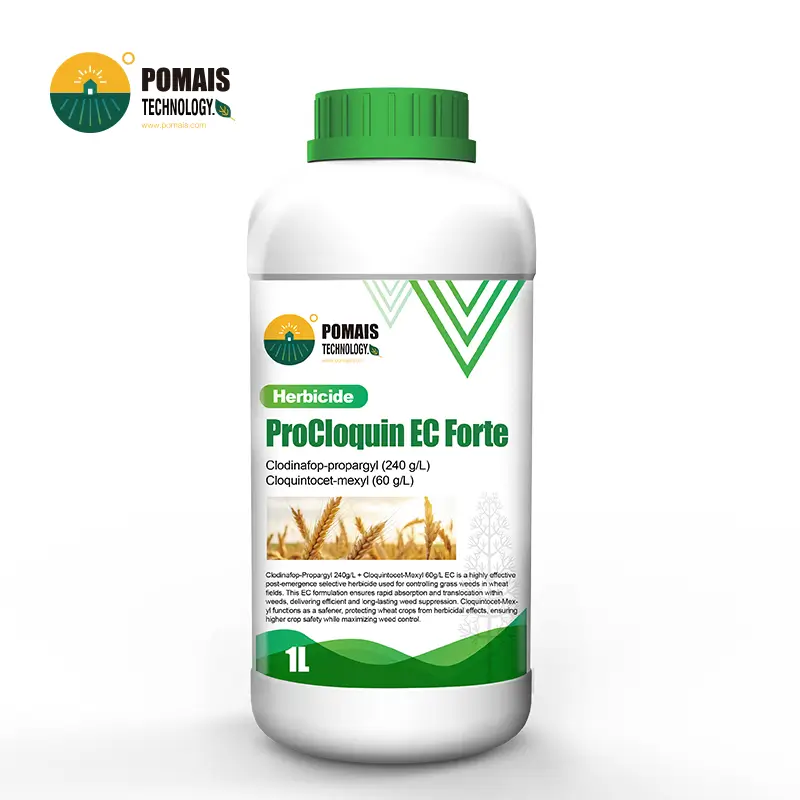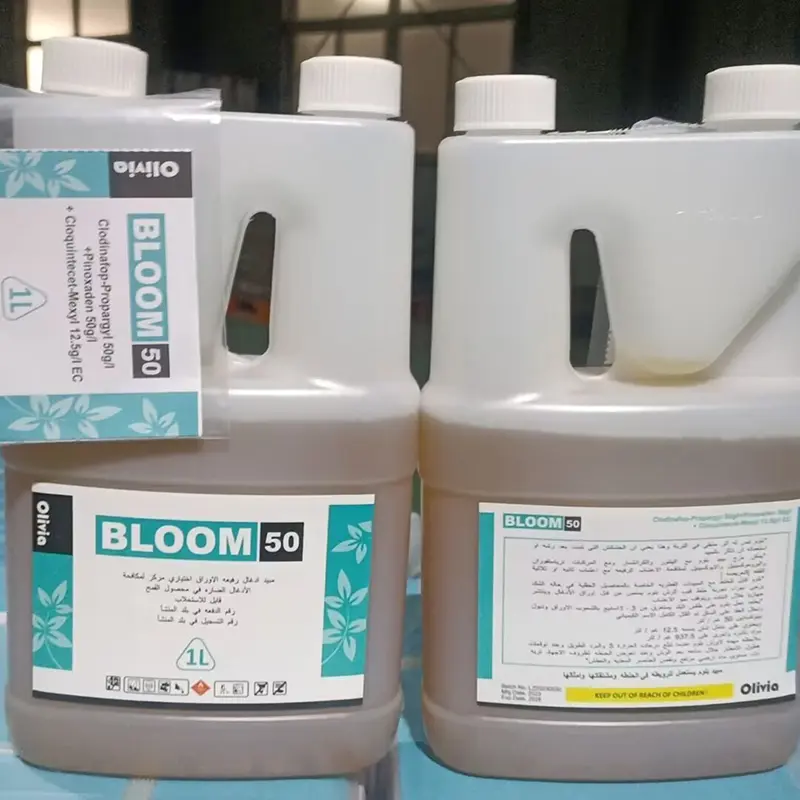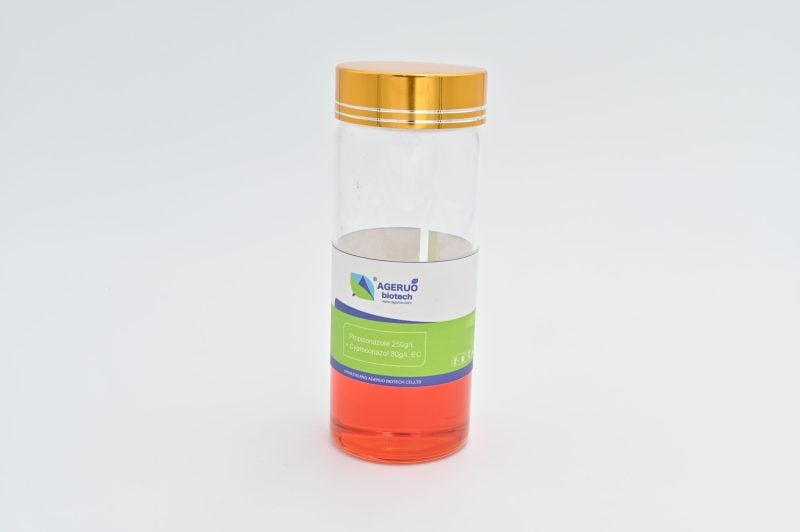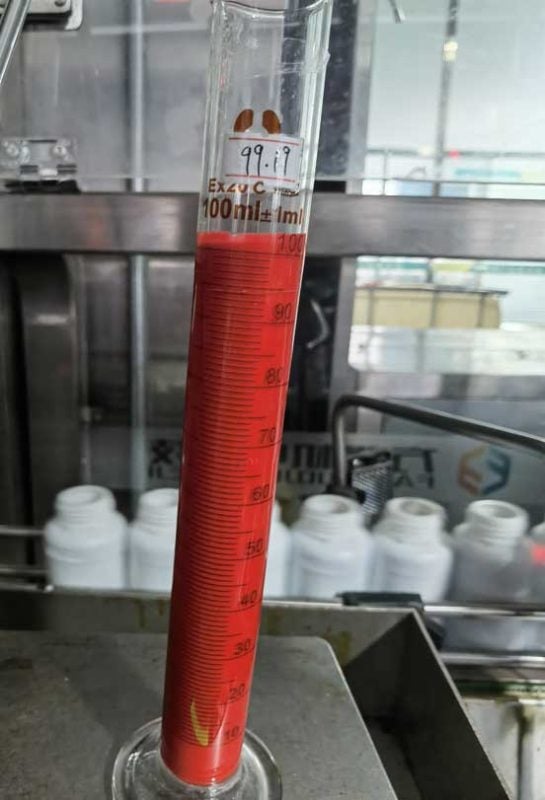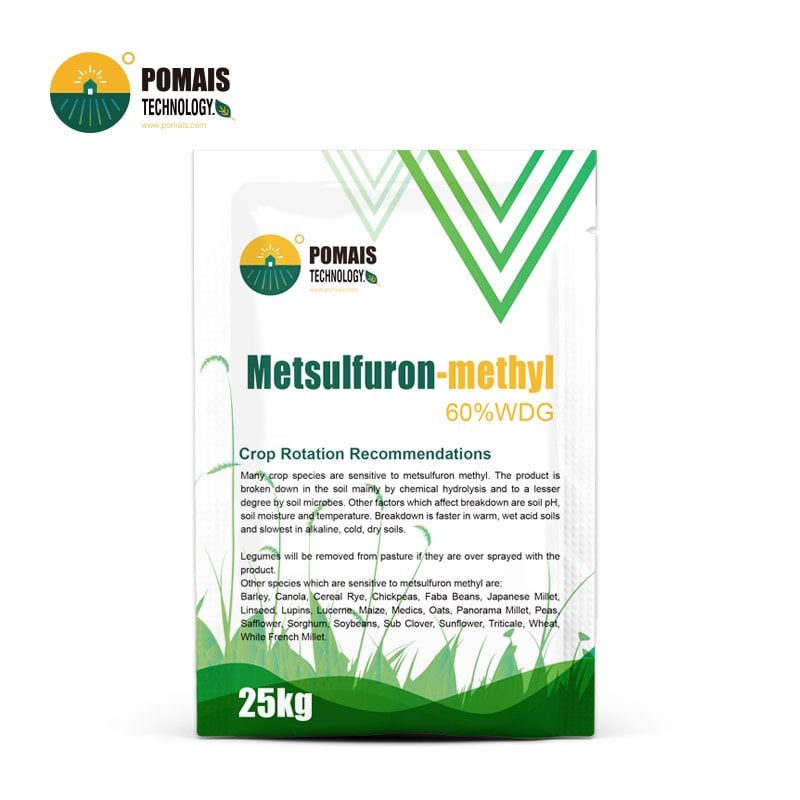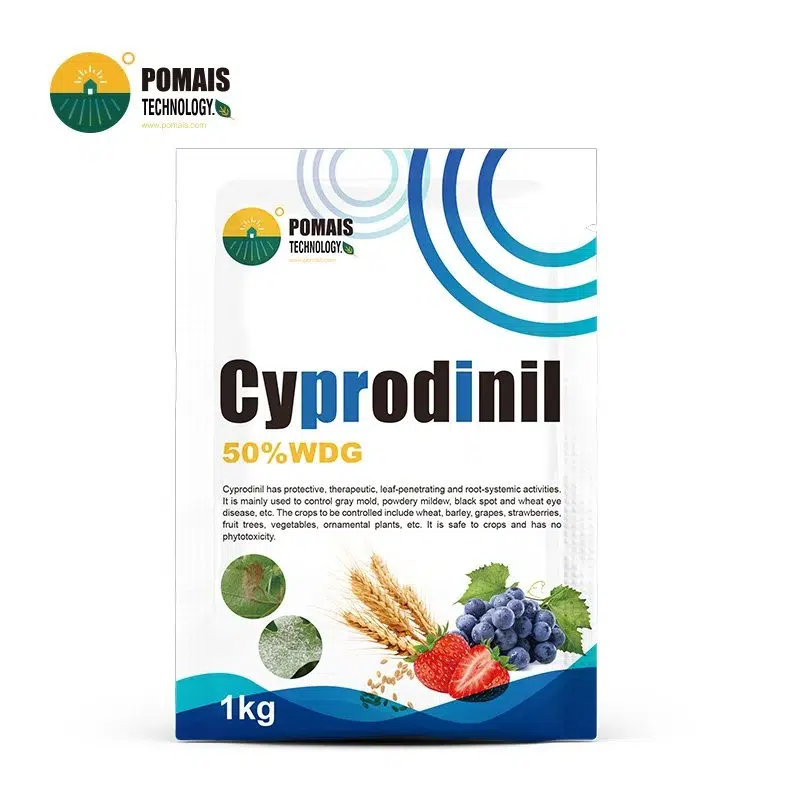Clodinafop-Propargyl 240g/L + Cloquintocet-Mexyl 60g/L EC Herbicide
Clodinafop-Propargyl 240g/L + Cloquintocet-Mexyl 60g/L EC is a highly selective post-emergence herbicide developed to deliver reliable grass weed control in wheat and barley crops. This advanced EC formulation combines the strong ACCase-inhibiting power of Clodinafop-Propargyl with the crop safety protection of Cloquintocet-Mexyl as a safener. By targeting resistant annual grass weeds such as wild oats, ryegrass, foxtail, and canarygrass, it helps growers maintain clean fields, protect yields, and reduce costly weed competition.
This solution is trusted by importers, distributors, and farm operators seeking effective weed management, rapid action, and consistent crop safety. Backed by POMAIS’s OEM supply and flexible packaging services, it is ready to support your local market with reliable performance and clear field results.
- Designed for Professional Buyers & Bulk Orders
- This product is available for business purchase and large-scale distribution.
- We support custom packaging, labeling, and formulation to meet your market needs.
- Let’s build your brand together.

About Clodinafop-Propargyl 240g/L + Cloquintocet-Mexyl 60g/L EC Herbicide
About Clodinafop-Propargyl 240g/L + Cloquintocet-Mexyl 60g/L EC Herbicide
| Product Name | Clodinafop-propargyl 240g/L + Cloquintocet-mexyl 60g/L EC |
| Active Ingredients | Clodinafop-propargyl (240 g/L) Cloquintocet-mexyl (60 g/L) |
| Chemical Family | Aryloxyphenoxypropionate (Clodinafop-propargyl) Safener (Cloquintocet-mexyl) |
| CAS Number | Clodinafop-propargyl: 105512-06-9 Cloquintocet-mexyl: 99607-70-2 |
| Molecular Formula | Clodinafop-propargyl: C17H13ClFNO4 Cloquintocet-mexyl: C14H16ClNO3 |
| Mode of Action | Inhibits acetyl-CoA carboxylase (ACCase), disrupting lipid synthesis in grass weeds. Cloquintocet-mexyl acts as a safener to protect crops. |
| Formulation Type | Emulsifiable Concentrate (EC) |
| Target Weeds | Wild oats, Ryegrass, Foxtail, Brome, Canary grass, and other grass weeds |
| Target Crops | Wheat, Barley |
| Application Timing | Post-emergence (3-5 leaf stage of weeds) |
| Recommended Dosage | 200-300 ml/ha (varies based on weed pressure and crop conditions) |
| Application Method | Foliar spray using ground sprayers with fine droplet nozzles |
| Rainfastness | 1 hour after application |
| Solubility | Clodinafop-propargyl: Insoluble in water, soluble in organic solvents |
| Half-Life in Soil | 4-7 days (Clodinafop-propargyl) |
| Toxicity Classification | WHO Class III (Slightly Hazardous) |
| Environmental Impact | Low toxicity to birds and mammals, moderate toxicity to aquatic life |
| Storage Stability | Stable for 2 years when stored in a cool, dry place |
| Packaging Options | 1L, 5L, 20L HDPE bottles/drums or customized bulk packaging |
| Regulatory Compliance | FAO, WHO, EPA, EU Standards |
Clodinafop-Propargyl 240g/L + Cloquintocet-Mexyl 60g/L EC Herbicide – Selective Grass Weed Control for Wheat
Unlike ordinary grass weed herbicides, Clodinafop-Propargyl 240g/L + Cloquintocet-Mexyl 60g/L EC is engineered for maximum selectivity and crop safety. Clodinafop-Propargyl belongs to the aryloxyphenoxypropionate family and works by inhibiting the Acetyl-CoA Carboxylase (ACCase) enzyme, an essential component of lipid synthesis in grass weeds. This disrupts the weed’s cell growth process, stopping development within hours after application.
However, what sets this formulation apart is the inclusion of Cloquintocet-Mexyl, a trusted safener that protects wheat and barley from any unintended phytotoxic effects. This safener accelerates the crop’s natural metabolic breakdown of Clodinafop-Propargyl, ensuring that only target grass weeds are affected while the crop remains healthy and vigorous.
The result is a powerful post-emergence solution that knocks down annual grass weeds quickly and keeps working with residual control. From wild oats and Italian ryegrass to barnyardgrass and canarygrass, the broad spectrum makes this herbicide a valuable tool for farmers who need reliable performance and a wide application window.
Combined with POMAIS’s flexible supply chain, OEM packaging, and full technical support, this herbicide is designed to help you secure a stable market share in the competitive grass weed control sector.
Mode of Action & Safener Function
Clodinafop-Propargyl acts as a selective ACCase inhibitor, targeting the Acetyl-CoA Carboxylase enzyme that is vital for fatty acid synthesis in grass weeds. When this enzyme is blocked, the weeds can no longer produce essential lipids required for cell membrane integrity and new tissue growth. As a result, treated grass weeds stop growing within hours of application. Visible symptoms such as yellowing and leaf wilting follow within days, leading to complete weed death within two to three weeks, depending on conditions.
What makes this formulation different is its built-in Cloquintocet-Mexyl component, which serves as an effective crop safener. Cloquintocet-Mexyl enhances the wheat or barley plant’s natural metabolic processes, allowing the crop to rapidly break down Clodinafop-Propargyl residues without damage. This selective metabolism ensures that while grass weeds are controlled aggressively, the crop remains unharmed even under variable field conditions.
By combining an ACCase-inhibiting active with a trusted safener, this herbicide provides reliable weed control across diverse climates and weed pressure levels. It also plays a key role in resistance management programs by targeting grass weeds that have developed tolerance to older herbicide groups, helping maintain long-term field performance and stable yields.
Key Benefits
1. Selective Grass Weed Control for Wheat and Barley
Effectively eliminates key annual grass weeds such as wild oats, ryegrass, foxtail, barnyardgrass, and canarygrass while keeping your wheat crops safe from herbicide stress.
2. Rapid Weed Knockdown with Residual Effect
The Clodinafop-Propargyl active provides fast-acting growth inhibition. Weeds stop developing within hours, with residual control extending weed suppression and minimizing new flushes.
3. Proven Safener Protection
The built-in Cloquintocet-Mexyl safener enhances the crop’s natural detoxification process, ensuring that the herbicide is selectively active on weeds and not on your wheat or barley.
4. Wide Application Window & Tank Mix Flexibility
Suitable for early post-emergence applications from the 2-leaf to early tillering stage of weeds. Compatible with many broadleaf herbicides when applied sequentially, supporting integrated weed management strategies.
5. Cost-Effective Weed Management Solution
Delivers reliable performance even in fields with resistant grass weed populations, helping growers protect yield and reduce repeat herbicide passes. Ideal for bulk supply and flexible OEM packaging to match market demands.
Target Weeds & Suitable Crops
Clodinafop-Propargyl 240g/L + Cloquintocet-Mexyl 60g/L EC is designed for reliable grass weed control in cereal crops, especially wheat and barley. Its selective action makes it an essential tool for growers facing heavy infestations of annual grass weeds that compete aggressively for nutrients and water.
Common Grass Weeds Controlled
- Wild Oat (Avena fatua): One of the most economically damaging grass weeds in wheat fields worldwide.
- Canarygrass (Phalaris minor): Highly competitive in winter wheat regions.
- Barnyardgrass (Echinochloa spp.): Common in both dryland and irrigated fields.
- Italian Ryegrass (Lolium multiflorum): Notorious for herbicide resistance; best managed with ACCase inhibitors.
- Foxtail (Setaria spp.): Problematic in cereal rotations; often mixed infestations with wild oats.
- Volunteer Barley & Rye: Also suppressed effectively when present as grass weed volunteers.
Suitable Crops
- Wheat: Spring wheat and winter wheat varieties benefit most from selective grass weed control with minimal crop injury risk.
- Barley: Also suitable when applied according to local label guidelines, especially where Canarygrass or Ryegrass pose challenges.
By targeting the most troublesome annual grasses and ensuring high selectivity, this herbicide helps farmers maintain clean fields, reduce re-spraying costs, and protect cereal yields season after season.
Application Guidelines & Dosage
To achieve the best results with Clodinafop-Propargyl 240g/L + Cloquintocet-Mexyl 60g/L EC, it is crucial to apply at the right weed growth stage and under the right conditions. This ensures that the herbicide is absorbed quickly and translocated effectively to the growing points of target grass weeds.
Optimal Application Timing
- Post-Emergence Window: Apply when target grass weeds are in the 2- to 4-leaf stage. For certain species like wild oats and ryegrass, application during early tillering can also deliver good control if weeds are actively growing.
- Crop Stage: Best results are seen when wheat or barley is well established but before canopy closure. Avoid spraying on stressed crops suffering from drought, nutrient deficiency, or other stressors.
Recommended Dosage
| Crop | Target Weeds | Timing | Dosage (L/ha) | Application Method |
|---|---|---|---|---|
| Wheat | Wild Oats, Foxtail, Ryegrass | 2–4 leaf stage of weeds | 0.5–0.7 L/ha | Foliar spray with ground sprayer |
| Barley | Canarygrass, Barnyardgrass | Early tillering stage | 0.7–1.0 L/ha | Foliar spray with ground sprayer |
- Always use clean water to prepare the spray solution.
- Maintain uniform agitation to keep the emulsion stable.
- Calibrate nozzles to produce fine, even droplets for full leaf coverage.
Field Tips for Best Performance
- Spray When Weeds Are Actively Growing: Warm, moist soil conditions ensure better herbicide uptake.
- Rainfastness: This formulation becomes rainfast within about 1 hour after application, but avoid spraying if heavy rain is forecast within 4–6 hours.
- Spray Volume: Use 150–300 L/ha of water to ensure good coverage, especially in dense weed patches.
- Avoid Drift: Ensure the spray pattern does not drift onto non-target crops or field borders.
- Follow Local Label: Always follow local clodinafop-propargyl label instructions and re-entry intervals for worker safety.
By following these best practices, you help maximize the herbicide’s performance, extend residual weed suppression, and protect your wheat or barley crop for a healthy yield.
Tank Mix Compatibility & Precautions
Clodinafop-Propargyl 240g/L + Cloquintocet-Mexyl 60g/L EC is designed to integrate easily into your farm’s weed management program. Its compatibility with many broadleaf herbicides allows for flexible programs that deliver both grass and broadleaf weed control without compromising safety or efficacy.
Common Compatible Tank Mix Partners
- Clodinafop-Propargyl + Fenoxaprop-P-Ethyl: For fields with heavy grass weed pressure or multiple grass species. This combination broadens the grass weed control spectrum.
- Clodinafop-Propargyl + Metsulfuron-Methyl: Often used when broadleaf weeds are present alongside grass weeds. Apply sequentially or as a planned tank mix where local guidelines allow.
Important Precautions
- Avoid Mixing with Acidic Herbicides: Do not tank mix Clodinafop-Propargyl directly with strongly acidic herbicides like 2,4-D or Dicamba. These can reduce the performance of the ACCase inhibitor and potentially cause crop injury.
- Use Sequential Applications: For best results in broad-spectrum weed control, apply grass and broadleaf herbicides sequentially rather than in the same tank, unless your local agronomic guide confirms safe combinations.
- Jar Test Before Large Mixing: Always perform a small jar test when using unfamiliar product combinations. This helps detect any physical incompatibility or emulsion separation before field mixing.
- Maintain Clean Spray Equipment: Residues from other herbicides in the tank can affect spray quality or cause unintended crop injury. Flush sprayers thoroughly between herbicide applications.
- Follow Label Recommendations: Local labels may provide specific guidance on tank mixes, water pH adjustments, adjuvants, or buffer intervals. Always check local regulations to avoid off-label use.
Additional Tips for Best Results
- Ensure the spray solution is agitated continuously to keep the emulsion stable.
- Use high-quality water and maintain the recommended spray volume for full weed coverage.
- Monitor weather conditions. Avoid spraying when high winds may cause drift onto non-target crops.
By following these compatibility and safety guidelines, you get the maximum benefit from your Clodinafop-Propargyl herbicide while protecting your wheat or barley from unintended damage.
Field Use Scenarios for Wheat & Barley
Growers across different wheat and barley regions rely on Clodinafop-Propargyl + Cloquintocet-Mexyl EC for its consistent performance under varying field conditions. Here are some practical scenarios showing how this herbicide works best in the real world.
Scenario 1: Early-Season Wild Oat Infestation
In northern wheat belts, wild oats can emerge rapidly in cool, moist soil, competing with young wheat plants for nutrients and light. Farmers typically apply Clodinafop-Propargyl between the 2- and 4-leaf stage of wild oats when weeds are actively growing. This early post-emergence timing ensures fast uptake and translocation, leading to visible yellowing and wilting within days. A single application helps minimize the need for repeat passes and prevents yield losses.
Scenario 2: Mixed Ryegrass and Foxtail Pressure
In regions with diverse weed populations, growers often face mixed infestations of Italian ryegrass and foxtail species. Here, Clodinafop-Propargyl is integrated into an IWM (Integrated Weed Management) program. Applied post-emergence, the herbicide’s ACCase inhibition stops both species quickly. When needed, a compatible broadleaf herbicide is applied sequentially to tackle dicot weeds, ensuring the field stays clean throughout tillering.
Scenario 3: Fields with Herbicide-Resistant Grasses
Where repeated use of older herbicides has led to grass weed resistance, Clodinafop-Propargyl’s distinct mode of action plays a critical role. For growers managing resistant ryegrass, especially in no-till or conservation agriculture systems, this herbicide provides an effective rotation partner to break resistance cycles. The Cloquintocet-Mexyl safener ensures the wheat crop remains unaffected even when maximum label rates are used to suppress difficult infestations.
Scenario 4: Late Rain and New Weed Flush
In some areas, unexpected late rain can trigger a second flush of grass weeds. Because Clodinafop-Propargyl has residual suppression, it continues to protect the crop for 2–3 weeks after spraying. If pressure remains high, farmers can safely integrate a follow-up pass using a compatible grass or broadleaf herbicide, applied according to local best practice.
By adapting application timing and tank mixes to local weed pressure, growers can rely on Clodinafop-Propargyl 240g/L + Cloquintocet-Mexyl 60g/L EC to deliver efficient, selective grass weed control while preserving crop safety and yield potential.
FAQ – Common Questions
Q1: What is the recommended dosage for Clodinafop-Propargyl herbicide in wheat and barley?
The standard dosage range is 0.5–0.7 L/ha for wheat and 0.7–1.0 L/ha for barley, depending on weed species, growth stage, and local label guidelines. Always apply when grass weeds like wild oats or ryegrass are at the 2–4 leaf stage for best uptake and translocation.
Q2: How soon after spraying does rain affect Clodinafop-Propargyl performance?
This EC formulation is rainfast within about 1 hour after application under normal conditions. Avoid spraying if heavy rain is forecast within 4–6 hours to prevent dilution or runoff that could reduce grass weed control effectiveness.
Q3: Can Clodinafop-Propargyl be tank-mixed with other herbicides?
Yes. It is compatible with many broadleaf herbicides when used sequentially. For example, it is commonly applied with Metsulfuron-Methyl for mixed infestations or with Fenoxaprop-P-Ethyl for extended grass weed control. Always avoid same-tank mixing with strongly acidic herbicides like 2,4-D to maintain full ACCase inhibitor activity.
Q4: How does the Cloquintocet-Mexyl safener protect my wheat crop?
The safener boosts the crop’s natural metabolic pathways, allowing wheat and barley to break down Clodinafop-Propargyl residues more quickly. This selective action means weeds are controlled while your cereal crop remains healthy and free from herbicide injury.
Q5: How long does it take to see visible results in the field?
Grass weeds typically stop growing within hours of uptake. Visible yellowing and wilting appear within 3–7 days, and full control is usually achieved in 2–3 weeks, depending on weed pressure and environmental conditions.
Q6: How should I store this herbicide for best shelf life?
Keep the product in its original, sealed container. Store it in a cool, dry, well-ventilated area, away from direct sunlight and food or feed items. Under recommended storage, Clodinafop-Propargyl 240g/L + Cloquintocet-Mexyl 60g/L EC remains stable for at least 2 years.
Q7: Do you offer OEM supply and bulk pricing?
Yes. POMAIS provides flexible OEM services, multilingual labeling, and bulk packaging to suit your market needs. We support our partners with technical registration documents and competitive supply terms for large-scale grass weed control projects.
Why Choose POMAIS & Call to Action
When you partner with POMAIS, you’re choosing more than just a trusted supplier—you’re gaining a reliable team committed to helping you deliver proven weed control solutions to farmers and dealers in your region.
We combine high-purity active ingredients, ISO-certified production, and consistent formulation quality to ensure that every liter of Clodinafop-Propargyl herbicide you distribute performs exactly as promised in the field.
From flexible OEM packaging and multilingual labeling to full regulatory support and bulk delivery scheduling, our team works closely with importers, distributors, and large-scale growers to adapt to local requirements and market conditions.
We also provide up-to-date technical documentation and field guidance to help you position your grass weed control solutions competitively, even in areas with resistant weed pressure.
If you’re ready to secure a stable supply of Clodinafop-Propargyl 240g/L + Cloquintocet-Mexyl 60g/L EC Herbicide, request samples, or discuss bulk pricing and custom formulations,
contact the POMAIS team today—we’re here to support your market success every step of the way.
| Product Name | Clodinafop-propargyl 240g/L + Cloquintocet-mexyl 60g/L EC |
| Active Ingredients | Clodinafop-propargyl (240 g/L) Cloquintocet-mexyl (60 g/L) |
| Chemical Family | Aryloxyphenoxypropionate (Clodinafop-propargyl) Safener (Cloquintocet-mexyl) |
| CAS Number | Clodinafop-propargyl: 105512-06-9 Cloquintocet-mexyl: 99607-70-2 |
| Molecular Formula | Clodinafop-propargyl: C17H13ClFNO4 Cloquintocet-mexyl: C14H16ClNO3 |
| Mode of Action | Inhibits acetyl-CoA carboxylase (ACCase), disrupting lipid synthesis in grass weeds. Cloquintocet-mexyl acts as a safener to protect crops. |
| Formulation Type | Emulsifiable Concentrate (EC) |
| Target Weeds | Wild oats, Ryegrass, Foxtail, Brome, Canary grass, and other grass weeds |
| Target Crops | Wheat, Barley |
| Application Timing | Post-emergence (3-5 leaf stage of weeds) |
| Recommended Dosage | 200-300 ml/ha (varies based on weed pressure and crop conditions) |
| Application Method | Foliar spray using ground sprayers with fine droplet nozzles |
| Rainfastness | 1 hour after application |
| Solubility | Clodinafop-propargyl: Insoluble in water, soluble in organic solvents |
| Half-Life in Soil | 4-7 days (Clodinafop-propargyl) |
| Toxicity Classification | WHO Class III (Slightly Hazardous) |
| Environmental Impact | Low toxicity to birds and mammals, moderate toxicity to aquatic life |
| Storage Stability | Stable for 2 years when stored in a cool, dry place |
| Packaging Options | 1L, 5L, 20L HDPE bottles/drums or customized bulk packaging |
| Regulatory Compliance | FAO, WHO, EPA, EU Standards |
Clodinafop-Propargyl 240g/L + Cloquintocet-Mexyl 60g/L EC Herbicide – Selective Grass Weed Control for Wheat
Unlike ordinary grass weed herbicides, Clodinafop-Propargyl 240g/L + Cloquintocet-Mexyl 60g/L EC is engineered for maximum selectivity and crop safety. Clodinafop-Propargyl belongs to the aryloxyphenoxypropionate family and works by inhibiting the Acetyl-CoA Carboxylase (ACCase) enzyme, an essential component of lipid synthesis in grass weeds. This disrupts the weed’s cell growth process, stopping development within hours after application.
However, what sets this formulation apart is the inclusion of Cloquintocet-Mexyl, a trusted safener that protects wheat and barley from any unintended phytotoxic effects. This safener accelerates the crop’s natural metabolic breakdown of Clodinafop-Propargyl, ensuring that only target grass weeds are affected while the crop remains healthy and vigorous.
The result is a powerful post-emergence solution that knocks down annual grass weeds quickly and keeps working with residual control. From wild oats and Italian ryegrass to barnyardgrass and canarygrass, the broad spectrum makes this herbicide a valuable tool for farmers who need reliable performance and a wide application window.
Combined with POMAIS’s flexible supply chain, OEM packaging, and full technical support, this herbicide is designed to help you secure a stable market share in the competitive grass weed control sector.
Mode of Action & Safener Function
Clodinafop-Propargyl acts as a selective ACCase inhibitor, targeting the Acetyl-CoA Carboxylase enzyme that is vital for fatty acid synthesis in grass weeds. When this enzyme is blocked, the weeds can no longer produce essential lipids required for cell membrane integrity and new tissue growth. As a result, treated grass weeds stop growing within hours of application. Visible symptoms such as yellowing and leaf wilting follow within days, leading to complete weed death within two to three weeks, depending on conditions.
What makes this formulation different is its built-in Cloquintocet-Mexyl component, which serves as an effective crop safener. Cloquintocet-Mexyl enhances the wheat or barley plant’s natural metabolic processes, allowing the crop to rapidly break down Clodinafop-Propargyl residues without damage. This selective metabolism ensures that while grass weeds are controlled aggressively, the crop remains unharmed even under variable field conditions.
By combining an ACCase-inhibiting active with a trusted safener, this herbicide provides reliable weed control across diverse climates and weed pressure levels. It also plays a key role in resistance management programs by targeting grass weeds that have developed tolerance to older herbicide groups, helping maintain long-term field performance and stable yields.
Key Benefits
1. Selective Grass Weed Control for Wheat and Barley
Effectively eliminates key annual grass weeds such as wild oats, ryegrass, foxtail, barnyardgrass, and canarygrass while keeping your wheat crops safe from herbicide stress.
2. Rapid Weed Knockdown with Residual Effect
The Clodinafop-Propargyl active provides fast-acting growth inhibition. Weeds stop developing within hours, with residual control extending weed suppression and minimizing new flushes.
3. Proven Safener Protection
The built-in Cloquintocet-Mexyl safener enhances the crop’s natural detoxification process, ensuring that the herbicide is selectively active on weeds and not on your wheat or barley.
4. Wide Application Window & Tank Mix Flexibility
Suitable for early post-emergence applications from the 2-leaf to early tillering stage of weeds. Compatible with many broadleaf herbicides when applied sequentially, supporting integrated weed management strategies.
5. Cost-Effective Weed Management Solution
Delivers reliable performance even in fields with resistant grass weed populations, helping growers protect yield and reduce repeat herbicide passes. Ideal for bulk supply and flexible OEM packaging to match market demands.
Target Weeds & Suitable Crops
Clodinafop-Propargyl 240g/L + Cloquintocet-Mexyl 60g/L EC is designed for reliable grass weed control in cereal crops, especially wheat and barley. Its selective action makes it an essential tool for growers facing heavy infestations of annual grass weeds that compete aggressively for nutrients and water.
Common Grass Weeds Controlled
- Wild Oat (Avena fatua): One of the most economically damaging grass weeds in wheat fields worldwide.
- Canarygrass (Phalaris minor): Highly competitive in winter wheat regions.
- Barnyardgrass (Echinochloa spp.): Common in both dryland and irrigated fields.
- Italian Ryegrass (Lolium multiflorum): Notorious for herbicide resistance; best managed with ACCase inhibitors.
- Foxtail (Setaria spp.): Problematic in cereal rotations; often mixed infestations with wild oats.
- Volunteer Barley & Rye: Also suppressed effectively when present as grass weed volunteers.
Suitable Crops
- Wheat: Spring wheat and winter wheat varieties benefit most from selective grass weed control with minimal crop injury risk.
- Barley: Also suitable when applied according to local label guidelines, especially where Canarygrass or Ryegrass pose challenges.
By targeting the most troublesome annual grasses and ensuring high selectivity, this herbicide helps farmers maintain clean fields, reduce re-spraying costs, and protect cereal yields season after season.
Application Guidelines & Dosage
To achieve the best results with Clodinafop-Propargyl 240g/L + Cloquintocet-Mexyl 60g/L EC, it is crucial to apply at the right weed growth stage and under the right conditions. This ensures that the herbicide is absorbed quickly and translocated effectively to the growing points of target grass weeds.
Optimal Application Timing
- Post-Emergence Window: Apply when target grass weeds are in the 2- to 4-leaf stage. For certain species like wild oats and ryegrass, application during early tillering can also deliver good control if weeds are actively growing.
- Crop Stage: Best results are seen when wheat or barley is well established but before canopy closure. Avoid spraying on stressed crops suffering from drought, nutrient deficiency, or other stressors.
Recommended Dosage
| Crop | Target Weeds | Timing | Dosage (L/ha) | Application Method |
|---|---|---|---|---|
| Wheat | Wild Oats, Foxtail, Ryegrass | 2–4 leaf stage of weeds | 0.5–0.7 L/ha | Foliar spray with ground sprayer |
| Barley | Canarygrass, Barnyardgrass | Early tillering stage | 0.7–1.0 L/ha | Foliar spray with ground sprayer |
- Always use clean water to prepare the spray solution.
- Maintain uniform agitation to keep the emulsion stable.
- Calibrate nozzles to produce fine, even droplets for full leaf coverage.
Field Tips for Best Performance
- Spray When Weeds Are Actively Growing: Warm, moist soil conditions ensure better herbicide uptake.
- Rainfastness: This formulation becomes rainfast within about 1 hour after application, but avoid spraying if heavy rain is forecast within 4–6 hours.
- Spray Volume: Use 150–300 L/ha of water to ensure good coverage, especially in dense weed patches.
- Avoid Drift: Ensure the spray pattern does not drift onto non-target crops or field borders.
- Follow Local Label: Always follow local clodinafop-propargyl label instructions and re-entry intervals for worker safety.
By following these best practices, you help maximize the herbicide’s performance, extend residual weed suppression, and protect your wheat or barley crop for a healthy yield.
Tank Mix Compatibility & Precautions
Clodinafop-Propargyl 240g/L + Cloquintocet-Mexyl 60g/L EC is designed to integrate easily into your farm’s weed management program. Its compatibility with many broadleaf herbicides allows for flexible programs that deliver both grass and broadleaf weed control without compromising safety or efficacy.
Common Compatible Tank Mix Partners
- Clodinafop-Propargyl + Fenoxaprop-P-Ethyl: For fields with heavy grass weed pressure or multiple grass species. This combination broadens the grass weed control spectrum.
- Clodinafop-Propargyl + Metsulfuron-Methyl: Often used when broadleaf weeds are present alongside grass weeds. Apply sequentially or as a planned tank mix where local guidelines allow.
Important Precautions
- Avoid Mixing with Acidic Herbicides: Do not tank mix Clodinafop-Propargyl directly with strongly acidic herbicides like 2,4-D or Dicamba. These can reduce the performance of the ACCase inhibitor and potentially cause crop injury.
- Use Sequential Applications: For best results in broad-spectrum weed control, apply grass and broadleaf herbicides sequentially rather than in the same tank, unless your local agronomic guide confirms safe combinations.
- Jar Test Before Large Mixing: Always perform a small jar test when using unfamiliar product combinations. This helps detect any physical incompatibility or emulsion separation before field mixing.
- Maintain Clean Spray Equipment: Residues from other herbicides in the tank can affect spray quality or cause unintended crop injury. Flush sprayers thoroughly between herbicide applications.
- Follow Label Recommendations: Local labels may provide specific guidance on tank mixes, water pH adjustments, adjuvants, or buffer intervals. Always check local regulations to avoid off-label use.
Additional Tips for Best Results
- Ensure the spray solution is agitated continuously to keep the emulsion stable.
- Use high-quality water and maintain the recommended spray volume for full weed coverage.
- Monitor weather conditions. Avoid spraying when high winds may cause drift onto non-target crops.
By following these compatibility and safety guidelines, you get the maximum benefit from your Clodinafop-Propargyl herbicide while protecting your wheat or barley from unintended damage.
Field Use Scenarios for Wheat & Barley
Growers across different wheat and barley regions rely on Clodinafop-Propargyl + Cloquintocet-Mexyl EC for its consistent performance under varying field conditions. Here are some practical scenarios showing how this herbicide works best in the real world.
Scenario 1: Early-Season Wild Oat Infestation
In northern wheat belts, wild oats can emerge rapidly in cool, moist soil, competing with young wheat plants for nutrients and light. Farmers typically apply Clodinafop-Propargyl between the 2- and 4-leaf stage of wild oats when weeds are actively growing. This early post-emergence timing ensures fast uptake and translocation, leading to visible yellowing and wilting within days. A single application helps minimize the need for repeat passes and prevents yield losses.
Scenario 2: Mixed Ryegrass and Foxtail Pressure
In regions with diverse weed populations, growers often face mixed infestations of Italian ryegrass and foxtail species. Here, Clodinafop-Propargyl is integrated into an IWM (Integrated Weed Management) program. Applied post-emergence, the herbicide’s ACCase inhibition stops both species quickly. When needed, a compatible broadleaf herbicide is applied sequentially to tackle dicot weeds, ensuring the field stays clean throughout tillering.
Scenario 3: Fields with Herbicide-Resistant Grasses
Where repeated use of older herbicides has led to grass weed resistance, Clodinafop-Propargyl’s distinct mode of action plays a critical role. For growers managing resistant ryegrass, especially in no-till or conservation agriculture systems, this herbicide provides an effective rotation partner to break resistance cycles. The Cloquintocet-Mexyl safener ensures the wheat crop remains unaffected even when maximum label rates are used to suppress difficult infestations.
Scenario 4: Late Rain and New Weed Flush
In some areas, unexpected late rain can trigger a second flush of grass weeds. Because Clodinafop-Propargyl has residual suppression, it continues to protect the crop for 2–3 weeks after spraying. If pressure remains high, farmers can safely integrate a follow-up pass using a compatible grass or broadleaf herbicide, applied according to local best practice.
By adapting application timing and tank mixes to local weed pressure, growers can rely on Clodinafop-Propargyl 240g/L + Cloquintocet-Mexyl 60g/L EC to deliver efficient, selective grass weed control while preserving crop safety and yield potential.
FAQ – Common Questions
Q1: What is the recommended dosage for Clodinafop-Propargyl herbicide in wheat and barley?
The standard dosage range is 0.5–0.7 L/ha for wheat and 0.7–1.0 L/ha for barley, depending on weed species, growth stage, and local label guidelines. Always apply when grass weeds like wild oats or ryegrass are at the 2–4 leaf stage for best uptake and translocation.
Q2: How soon after spraying does rain affect Clodinafop-Propargyl performance?
This EC formulation is rainfast within about 1 hour after application under normal conditions. Avoid spraying if heavy rain is forecast within 4–6 hours to prevent dilution or runoff that could reduce grass weed control effectiveness.
Q3: Can Clodinafop-Propargyl be tank-mixed with other herbicides?
Yes. It is compatible with many broadleaf herbicides when used sequentially. For example, it is commonly applied with Metsulfuron-Methyl for mixed infestations or with Fenoxaprop-P-Ethyl for extended grass weed control. Always avoid same-tank mixing with strongly acidic herbicides like 2,4-D to maintain full ACCase inhibitor activity.
Q4: How does the Cloquintocet-Mexyl safener protect my wheat crop?
The safener boosts the crop’s natural metabolic pathways, allowing wheat and barley to break down Clodinafop-Propargyl residues more quickly. This selective action means weeds are controlled while your cereal crop remains healthy and free from herbicide injury.
Q5: How long does it take to see visible results in the field?
Grass weeds typically stop growing within hours of uptake. Visible yellowing and wilting appear within 3–7 days, and full control is usually achieved in 2–3 weeks, depending on weed pressure and environmental conditions.
Q6: How should I store this herbicide for best shelf life?
Keep the product in its original, sealed container. Store it in a cool, dry, well-ventilated area, away from direct sunlight and food or feed items. Under recommended storage, Clodinafop-Propargyl 240g/L + Cloquintocet-Mexyl 60g/L EC remains stable for at least 2 years.
Q7: Do you offer OEM supply and bulk pricing?
Yes. POMAIS provides flexible OEM services, multilingual labeling, and bulk packaging to suit your market needs. We support our partners with technical registration documents and competitive supply terms for large-scale grass weed control projects.
Why Choose POMAIS & Call to Action
When you partner with POMAIS, you’re choosing more than just a trusted supplier—you’re gaining a reliable team committed to helping you deliver proven weed control solutions to farmers and dealers in your region.
We combine high-purity active ingredients, ISO-certified production, and consistent formulation quality to ensure that every liter of Clodinafop-Propargyl herbicide you distribute performs exactly as promised in the field.
From flexible OEM packaging and multilingual labeling to full regulatory support and bulk delivery scheduling, our team works closely with importers, distributors, and large-scale growers to adapt to local requirements and market conditions.
We also provide up-to-date technical documentation and field guidance to help you position your grass weed control solutions competitively, even in areas with resistant weed pressure.
If you’re ready to secure a stable supply of Clodinafop-Propargyl 240g/L + Cloquintocet-Mexyl 60g/L EC Herbicide, request samples, or discuss bulk pricing and custom formulations,
contact the POMAIS team today—we’re here to support your market success every step of the way.
Related Products
Latest News

